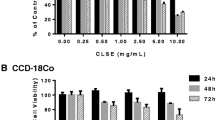Abstract
Anti-metastatic activities of IH901, an intestinal bacterial metabolic derivative formed from Ginseng protopanaxadiol saponins, was determinedin vitro andin vivo. Underin vitro conditions, IH901 inhibited the migration of bovine aortic endothelial cells 25 times stronger than suramin and suppressed the invasion of HT1080 human fibrosarcoma cells into reconstituted basement membrane components of Matrigel 1000 times stronger than RGDS peptide. IH901 also showed inhibitory effect on type-IV collagenase secretion from HT1080 cells and platelet aggregation. When the anti-metastatic activity of IH901 was evaluated in comparison with that of 5-FU using a spontaneous lung metastatic model of Lewis lung carcinoma, the administration of IH901 (10 mg/kg p. o.) to tumor-bearing mice led to a significant decrease in lung metastasis (43% of untreated control), which was slightly more effective than that obtained with 5-FU (56% of control). Thus, IH901 seems to exhibit its anti-metastatic activity partly through the inhibition of tumor invasion which results from the blockade of type IV collagenase secretion and also through anti-platelet and anti-angiogenic activities.
Similar content being viewed by others
References Cited
Fidler, I. J., The Ernst W. Bernet memorial award lecture: the evolution of biological heterogeneity in metastatic neoplasms. In Nicolson G. L. and Milas, L. (Eds.).Cancer invasion and metastases: Biologic and therapeutic aspects. Raven Press New York, pp. 5–26 (1984).
Gagliardi, A., Hadd, H. and Collins, D. C., Inhibition of angiogenesis by suramin.Cancer Res., 52, 5073–5075 (1992).
Hasegawa, H., Matsumiya, S., Uchiyama, M., Kurokawa, T., Inouye, Y., Kasai, R., Ishibashi, S. and Yamasaki, K., Inhibitory effect of some triterpenoid saponins on glucose transport in tumor cells and its application toin vitro cytotoxic and antiviral activities.Planta Med., 60, 240–243 (1994).
Hasegawa, H., Matsumiya, S., Uchiyama, M., Inouye, Y., Kasai, R. and Yamasaki, K., Reversal of effluxmediated tetracycline resistance inStaphylococcus aureus clinical isolates by Ginseng prosapogenins.Phytother. Res., 9, 260–263 (1995a).
Hasegawa, H., Sung, J. H., Matsumiya, S., Uchiyama, M., Inouye, Y., Kasai, R. and Yamasaki, K., Reversal of daunomycin and vinblastine resistance in multidrug-resistant P388 leukemiain vitro through enhanced cytotoxicity by triterpenoids.Planta Med., 61, 409–413 (1995b).
Hasegawa, H., Sung, J. H., Matsumiya, S. and Uchiyama, M., Main Ginseng saponin metabolites formed by intestinal bacteria.Planta Med., 62, 453–457 (1996).
Hart, I. R., “Seed and soil” revisited: mechanisms of site specific metastasis.Cancer Metastasis Rev., 1, 5–16 (1982).
Kobayashi, H., Shinohara, H., Fujie, M., Gotoh, J., Itoh, M., Takeuchi, K. and Terao, T., Inhibition of metastasis of Lewis lung carcinoma by urinary trypsin inhibitor in experimental and spontaneous metastasis model.Int. J. Cancer, 63, 455–462 (1995).
Liotta, L. A., Rao, C. V. and Barsky, S. H., Tumor invasion and the extracellular matrix.Lab. Invest., 49, 636–649 (1983).
Moll, U. M., Youngeleib, G. L., Rosinski, K. B. and Quigley, J. P., Tumor promotor-stimulated Mr 92, 000 gelatinase secreted by normal and malignant human cells: Isolation and characterization of the enzyme from HT1080 tumor cells.Cancer Res., 50, 6162–6170 (1990).
Nicolson, G. L., Tumor cell instability, diversification, and progression to the metastatic phenotype: from oncogene to oncofetal expression.Cancer Res. 47 1473–1487 (1987).
O’Brien, J. R., Platelet aggregation.J. Clin. Pathol., 15, 446–455 (1962).
Saiki, I., Iida, J., Murata, J., Ogawa, R., Nishi, N., Sugimura, K., Tokura, S. and Azuma, I, Inhibition of the metastasis of murine malignant melanoma by synthetic polymeric peptides containing core sequences of cell-adhesive molecules.Cancer Res., 49, 3815–3822 (1989a).
Saiki, I., Murata, J., Watanabe, K., Fujii, H., Abe, F. and Azuma, I., Inhibition of tumor-cell invasion by ubenimex (bestatin)in vitro.Jpn. J. Cancer Res., 80, 873–878 (1989b).
Sato, Y. and Rifkin, D. B., Autocrine activities of basic fibroblast growth factor: regulation of endothelial cell movement, plasminogen activator synthesis, and DNA synthesis.J. Cell Biol., 107, 1199–1205 (1988).
Talmadge, J. E., Lenz, B. F., Pennington, R., Long, C., Phillips, H., Schneider, M. and Tribble, H., Immunomodulatory and therapeutic properties of bestatin in mice.Cancer Res., 46, 4505–4510 (1986).
Wang, X., Fu, X., Brown, P. D., Crimmin, M. J. and Hoffman, R. M., Matrix metalloprotease inhibitor BB-94 (Batimastat) inhibits human colon tumor growth and spread in a patient-like orthotopic model in nude mice.Cancer Res., 54, 4726–4728 (1994).
Author information
Authors and Affiliations
Rights and permissions
About this article
Cite this article
Hasegawa, H., Sung, JH. & Huh, JH. Ginseng intestinal bacterial metabolite IH901 as a new anti-metastatic agent. Arch. Pharm. Res. 20, 539–544 (1997). https://doi.org/10.1007/BF02975208
Received:
Issue Date:
DOI: https://doi.org/10.1007/BF02975208




